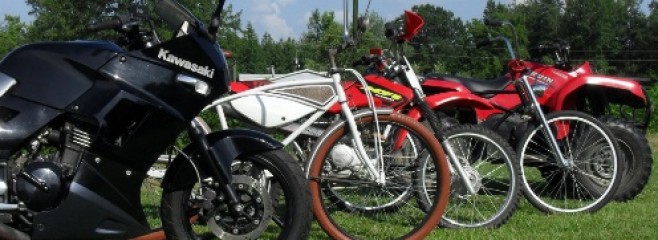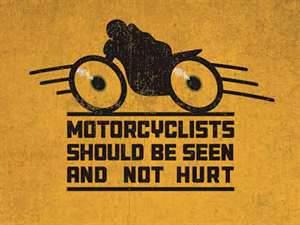Virginia Tech Motorcycle Safety Study
1981 was a long time ago; 33 years ago in fact that’s when Dr. Harry Hurt and his team published the now famous Hurt Report study of motorcycle accidents. This author is not personally aware of any large scale studies done prior to this. Dr. Hurt & his team conducted in depth analysis of several hundred motorcycle accidents in and around Los Angeles, California in 1976 & 77. This study is still the basic benchmark for most motorcycle related safety regulation & recommendations in America today.
This was fantastic work but by the time the report was published in 81 the data was already 4 years old and the state of the motorcycle industry was in the midst of serious change starting into the 1980s. In 1977 the most powerful “normal production” motorcycles on the street were air cooled inline fours from Japan, or modified Sportsters. (Yes youngsters at one time the XLCH was actually a badass motorcycle and not an overweight beginner’s cruiser.) The new decade saw a revolution in the power levels and handling of the Japanese sport bikes, and legendary machines like the Interceptor, FZR, Ninja, and the almighty GSXR. These motorcycles in box stock trim had power and handling undreamed of even in professional racing machines in 1977.
At the other end of the industry, the cruiser revolution was taking off. Jump started by the Reagan administrations bailout and swept along on a proud current of patriotic fever, Americans who had never in their life considered owning a motorcycle, rushed out to buy new Harleys powered by the reliable new Evolution engine. Millions of beginners took to the highways on brand new 1340cc machines. It was a glorious time. Even the big four got in on the act producing similar machines for those still dis-trustful of H-D quality.
The late ‘70s & early ‘80s had been slow times for motorcycle sales but by 1985 things were busting out all over, but it was a completely different scene. Today there’s good sized “retro” market for vintage styled machines resembling their ’60s & ‘70s counterparts, but with modern fuel injection, brakes & materials. A 2014 Ninja is as far advanced from a 1984 GPZ900R as the GPZ was from a ’69 Triumph Bonneville. Here in 2014 1300cc is considered to be a midsized cruiser. The greatest change of all is that there were no cell phones back in 1977. Things have changed so much. Ten years from now it will be different from what it is today, count on it.
In 1999 in Europe the MAIDS report was released. The Motorcycle Accident In Depth Study was yet another study of accident reports focused on all powered two wheel vehicles, including the moped class machines. In 2009 the organization released MAIDS 2.0 which I am certain was based on the same data set (please correct me if I am wrong) but segregated the 50cc mopeds from the larger motorcycles because the smaller machines tended to have much higher accident rates, skewing the results of the study.
Both of these studies are cause & effect studies based on accident reports. They broke the accidents and their causes various logical groups, and really did help to sort out what things were done wrong by those involved in motorcycle crashes. But to me the best way to improve safety is to find out what those who do not crash are doing right. This brings me to the current studies being conducted by the Virginia Tech Transportation Institute. First I would like to thank one of their research associates a talented young engineer by the name of Cameron Rainey for making me aware of it, and helping me to better understand the focus of it. This is a series of naturalistic studies, involving real motorcyclists who agree to have their motorcycles outfitted with telemetry equipment & cameras. The motorcycles and riders are monitored, speed, position & conditions tracked for set time periods. In order to get true results from the study participants are given immunity from prosecution. I have no doubt that knowing that they were being observed caused some people to alter their riding some, but without this immunity allowing riders to behave as they normally would without fear of prosecution, this study would be completely useless. Let’s be honest here, how many of us don’t at least speed, or filter through traffic every once in a while. Okay put your hands down, all three of you
You can’t help but wonder how many of our pre-conceived notions will be challenged when the results of this new study are published. For example I always run my high beam headlight during daylight hours, does this really make me more visible or just piss people off? Another unproven belief of mine is that it is always better to stay out of a pack of cars whenever possible even if it means speeding through them or driving below the speed limit to get away from them. I do think that unless the traffic is traveling at ludicrous speed it is better to go a little faster than them, going slower than the posted speed will get you treated as an obstacle like a moped or a bicycle & tempt others to pass you in a dangerous matter. Plus I would die of shame if I were on a motorcycle and holding up a line of cars behind me.

One thing that I hope is still true from the Hurt report is that deliberate hostile action by drivers of other vehicles against motorcyclists is still a negligible, inconsequential percentage of the causes for crashes today. At this time my personal belief is that deliberate hostile intimidating action by other drivers has increased greatly no matter what you are driving. I hope they prove me wrong.
Please go check out their website, and don’t just glance at the homepage, take time to dig through it, sign up to volunteer in case they decide to do a study in your area. It will be interesting to see the completed report and compare it to past studies and to our beliefs, instincts, and gut feelings. It would also be interesting to hear from you dear reader, what are some of your beliefs about safety on the road? If you find out you are wrong about something will you be willing to adjust your riding style? Please tell me in the comments section below. (First comments are moderated so please allow time for them to be posted)
Peace Y’all
Relevant links used for research.
Virginia Tech Motorcycle Safety Study
The Hurt Report Summary
The Motorcycle Accident In Depth Study



